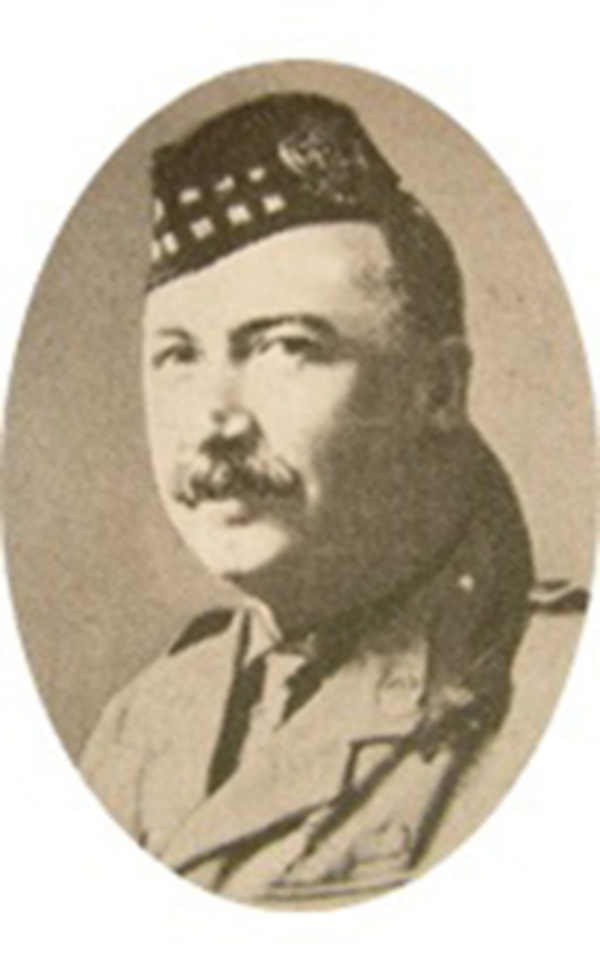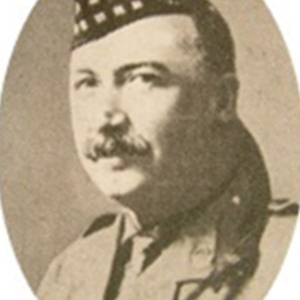
Source: Link
CURRIE, JOHN ALLISTER (Alistar), merchant, journalist, militia officer, author, businessman, politician, and army officer; b. 25 Feb. 1862 at Nottawa, Upper Canada, son of John Currie and Catherine McAllister; m. 6 June 1893 Elizabeth Helen Sparks (d. 2 April 1938) in Toronto, and they had one daughter; d. 28 June 1931 in Miami, Fla.
J. A. Currie’s parents, both Scottish immigrants, settled in Simcoe County, Upper Canada. John studied at the public school in Nottawa and then at the collegiate institute in Collingwood. For five years he apprenticed as a hardware merchant before turning his attention to journalism. From 1886 to 1897 he worked as a reporter, employed first by Toronto’s Evening News and then the Toronto Daily Mail, which, owing to a merger in 1895, would become the Mail and Empire. Possessing talent and a competitive nature, he quickly moved up the ranks, eventually representing his paper in the press gallery of the provincial legislature. He also contributed to magazines and in 1892 published a book of poems he had written for pleasure.
In the mid 1890s the Mail and Empire sent Currie to British Columbia to report on the gold-mining boom, and it was perhaps because of this experience that he was drawn to prospecting and business. He worked as a mining broker in Toronto, and in 1897 he and a group of colleagues founded the Standard Stock and Mining Exchange, which in 1899 merged with its rival, the Toronto Stock and Mining Exchange (it would become part of the Toronto Stock Exchange in 1934). In 1905 he joined other entrepreneurs to incorporate the Imperial Steel and Wire Company Limited in Collingwood. Currie was managing director and later president of the firm, which manufactured fencing, wire staples and nails, and netting and screens.
Currie’s developing interest in political pursuits had led him to stand as the Conservative candidate for Simcoe North in the 1904 federal election. He was unsuccessful but would win the seat in 1908 and be re-elected in 1911. He voiced his party’s opposition to the reciprocity advocated by William Stevens Fielding* on behalf of Sir Wilfrid Laurier*’s Liberals. In 1910 his efforts had helped bring about an amendment to a tariff policy in order to protect Nova Scotia coal markets, which had been affected by competition from Pennsylvania.
Not only was Currie well known in business and political circles, but he was also active in the local militia. He had been selected as one of the original four captains of the 48th Battalion of Infantry (Highlanders) when it was formed in 1891 at the instigation of Alexander Fraser and others [see John Irvine Davidson*]. Currie was promoted major in 1908 and lieutenant-colonel and commanding officer in 1913. When Canada entered World War I in August 1914, Currie was one of the first in his community to take up the cause. He volunteered the 48th Highlanders for service, and in September the unit left for Valcartier, Que., where upon arrival they became the 15th Infantry Battalion. They reached England on 14 October with 46 officers and 1,109 men of other ranks, and there they became known among the British as the Red Watch. Four months later they headed to France as part of the 1st Division’s 3rd Canadian Infantry Brigade, under the command of Brigadier-General Richard Ernest William Turner*, whose brigade-major was Garnet Burk Hughes.
Currie commanded the Red Watch at Neuve-Chapelle in March 1915 and during the second battle of Ypres (Ieper), Belgium, where on 22 April the Germans first used chlorine gas against the Allies; this was followed by another attack two days later at Saint-Julien (Sint Juliaan). It seems that he was overwhelmed with horror during these barrages, and his experience would have a major effect on his actions following the battle. He claimed that he had been very close to the gas, encouraging his men to hold on as well as they did. Others asserted that he had lost his nerve and fled. Rumours circulated about a possible court martial. Currie gave up his command in June and was hospitalized in England. The next month he was sent to Canada, where he assisted with recruitment and instruction. Promoted full colonel, he took command of the 2nd Brigade at Camp Borden in Ontario.
A significant result of Currie’s military service was his desire to communicate his knowledge of the war to others. His account, “The Red Watch,” provided a detailed picture of soldiers’ experiences. The book, which went through several printings, contributed to a growing sense of nationalism. Currie stressed the theme of defending “Britons” (who, for many, included Canadians as members of the British empire) from the “Hun invaders,” and he hoped that his descriptions of “life and incidents of the campaign common to almost every corps in the field” would “encourage all young men to ‘take their places in the ranks’ and bear arms for the King and Empire.” His pride was evident: “As soon as a man donned the bronze shoulder badge with ‘Canada’ on it he became a Canadian, and forgot his hyphen. There was no mention of the British-born, the French-Canadian, or Canadian-born.” It was clear to Currie that Canadian troops were second to none: General Sir Horace Lockwood Smith-Dorrien had informed him that he and other Britons had been “much surprised to find that the Canadians were most excellent soldiers, that they were as highly trained as any British soldier who had come to France.” As Currie wrote, Canadians had “been in the trenches alongside of them, and have taken over their trenches and feel confident that we can do our work on any occasion just as well as any division in the British Army.” They had been tested at Ypres and had held their ground.
Currie devoted most of his post-war years to politics, exhibiting what would be described in 1934 as “certain aggressive tendencies which were perhaps characteristic of the Scottish stock from which he sprang. He generally spared neither friend nor foe in the pursuit of what he considered to be his duty.” During the war he had remained the mp for Simcoe North and was re-elected in 1917 under Sir Robert Laird Borden’s Unionist banner. He earned a reputation in the House of Commons as “a stormy petrel.” After the war he ran again as a Conservative but lost in 1921. His candidacy in the Toronto mayoral election of 1924 was also unsuccessful. He did, however, sit at Queen’s Park as an mpp for the riding of Toronto Southeast after winning a 1922 by-election; he was re-elected in 1923, when the Conservatives, led by George Howard Ferguson,* took power after defeating Ernest Charles Drury* and the United Farmers of Ontario. Currie served on several standing committees, including those related to public accounts, printing, municipal law, and fish and game. In 1926 he was returned to the legislature to represent the riding of St Patrick. His position on various issues, most notably his opposition to the Ontario Temperance Act, did not always please his colleagues, and in 1929 he was unable to secure the Conservative nomination. He persuaded his daughter, barrister Helen Whitfield Currie, to run in St Patrick as an independent Conservative, but she was defeated.
Currie had been briefly in the news in 1928 when a libel suit was brought by General Sir Arthur William Currie against a newspaper owner and journalist. Owing to the confusion about J. A. Currie’s behaviour during the second battle of Ypres and what had become known as the dugout incident, he was called as a witness for the defence. He acted disruptively and spoke out of turn. After disregarding repeated warnings that he was in contempt of court, he was removed by the sheriff. One account states that “he went out with the suggestion of a smirk on his face.”
While Currie’s manners were not universally praised, many admired his determined actions, and he was, according to a contemporary account, “very widely read and phenomenally well-informed on a broad range of subjects.” A Presbyterian, a freemason, and an Orangeman, he was a member of the Caledonian Society and the St Andrew’s Society. He was fond of hunting and curling, and in his youth he had enjoyed fencing. In Toronto he founded the Military Indoor Baseball League and the Miniature Rifle Club, both of which were associated with the 48th Highlanders. He was also a member of the Albany, Canadian, and Empire clubs of Toronto. Suffering from poor health during the final two years of his life, he died in a Miami hospital on 28 June 1931. He was buried in Mount Pleasant Cemetery, Toronto.
John Allister Currie is the author of a poetry collection, A quartette of lovers (Toronto, 1892), and of the military history “The Red Watch”: with the First Canadian Division in Flanders (London, 1916). On 25 Aug. 1914 he published an editorial (p.12) in the Canadian Military Gazette (Montreal) in which he predicted the trench warfare that was to come.
Can., National Defence and the Canadian Forces, Directorate of Hist. and Heritage (Ottawa), biog. file, box 57, J. A. Currie. LAC, R611-81-4 (15th Canadian Infantry Battalion); RG9-III-D-3 (War diaries – 15th Canadian Infantry Battalion); RG 150, Acc. 1992–93/166, box 2233-22. Northern Advance (Barrie, Ont.), 2 July 1931. Toronto Daily Star, 29 June 1931. Can., House of Commons, Debates, 1916. Canadian annual rev., 1915. Canadian directory of parl. (Johnson). Tim Cook, At the sharp end: Canadians fighting the Great War, 1914–1916 (Toronto, 2007); No place to run: the Canadian Corps and gas warfare in the First World War (Vancouver and Toronto, 1999). N. [M.] Greenfield, Baptism of fire: the second battle of Ypres and the forging of Canada, April 1915 (Toronto, 2007). Andrew Iarocci, Shoestring soldiers: the 1st Canadian Division at war, 1914–1915 (Toronto and Buffalo, N.Y., 2008). National encyclopedia of Canadian biography, ed. J. E. Middleton and W. S. Downs (2v., Toronto, 1935–37), 1. R. J. Sharpe, The last day, the last hour: the Currie libel trial ([Toronto], 1988). Standard dict. of Canadian biog. (Roberts and Tunnell), vol.1. W. F. Stewart, The embattled general: Sir Richard Turner and the First World War (Montreal and Kingston, Ont., 2015). Who’s who in Canada, 1928/29.
Cite This Article
John MacFarlane, “CURRIE, JOHN ALLISTER (Alistar),” in Dictionary of Canadian Biography, vol. 16, University of Toronto/Université Laval, 2003–, accessed November 27, 2024, https://www.biographi.ca/en/bio/currie_john_allister_16E.html.
The citation above shows the format for footnotes and endnotes according to the Chicago manual of style (16th edition). Information to be used in other citation formats:
| Permalink: | https://www.biographi.ca/en/bio/currie_john_allister_16E.html |
| Author of Article: | John MacFarlane |
| Title of Article: | CURRIE, JOHN ALLISTER (Alistar) |
| Publication Name: | Dictionary of Canadian Biography, vol. 16 |
| Publisher: | University of Toronto/Université Laval |
| Year of publication: | 2021 |
| Year of revision: | 2021 |
| Access Date: | November 27, 2024 |



